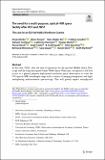| dc.contributor.author | Jahnke, Knud | |
| dc.contributor.author | Krause, Oliver | |
| dc.contributor.author | Rix, Hans-Walter | |
| dc.contributor.author | Courbin, Frédéric | |
| dc.contributor.author | Fontana, Adriano | |
| dc.contributor.author | Heymans, Catherine | |
| dc.contributor.author | Martin, Nicolas | |
| dc.contributor.author | Oesch, Pascal | |
| dc.contributor.author | Taylor, Andy | |
| dc.contributor.author | Gaudi, B. S | |
| dc.contributor.author | Kiessling, Alina | |
| dc.contributor.author | Mennesson, Bertrand | |
| dc.contributor.author | Seager, Sara | |
| dc.contributor.author | Stern, Daniel | |
| dc.contributor.author | Warfield, Keith | |
| dc.date.accessioned | 2021-11-01T14:33:21Z | |
| dc.date.available | 2021-11-01T14:33:21Z | |
| dc.date.issued | 2021-04-18 | |
| dc.identifier.uri | https://hdl.handle.net/1721.1/136784 | |
| dc.description.abstract | Abstract
In the early 2030s, after the end of operations for the epochal Hubble Space Telescope and the long-anticipated James Webb Space Telescope, astrophysics will lose access to a general purpose high-spatial resolution space observatory to cover the UV–optical–NIR wavelength range with a variety of imaging bandpasses and high-multiplexing mid-resolution spectroscopy. This will greatly impact astrophysical “discovery space” at visible wavelengths, in stark contrast to progress at most other wavelengths enabled by groundbreaking new facilities between 2010 and 2030. This capability gap will foreseeably limit progress in a number of fundamental research directions anticipated to be pressing in the 2030’s and beyond such as:
What are the histories of star formation and cosmic element production in nearby galaxies?
What can we learn about the nature of dark matter from dwarf galaxies?
What is the local value of the Hubble Constant?
A multi-purpose optical–NIR imaging and multiplexed spectroscopy Workhorse Camera (HWC) onboard NASA’s 4m-class Habitable Exoplanet Observatory (HabEx) space mission would provide access to these required data. HabEx is currently under study by NASA for the US Decadal Survey on Astronomy and Astrophysics 2020, and if selected would launch around 2035. Aside from its direct imaging of Earth-like exoplanets, it will have a general-observatory complement of instrumentation. The versatile Workhorse Camera will provide imaging and R
∼
$\sim $
1000 spectroscopy from 370nm to 1800nm, diffraction-limited over the whole wavelength range, with simultaneous observations of the visible and NIR. Spectroscopic multiplexing will be achieved through microshutter arrays. All necessary HWC technology is already at Technology Readiness Level 5, hence technological risks are low. HWC has a rough-order-of-magnitude (ROM) cost of 300 M€, and could be European-funded within the cost envelope of an ESA S-class mission in the Voyage 2050 program, with matching funds by national funding agencies to construct HWC by a European instrument consortium. This White Paper is intended to put a European HabEx Workhorse Camera into ESA’s considerations. If ESA shares the wide interest and if HabEx were to be selected by NASA, there would be ample time to identify interested institutes for a European instrument consortium, including MPIA, to design, finance, and build the HabEx Workhorse Camera. | en_US |
| dc.publisher | Springer Netherlands | en_US |
| dc.relation.isversionof | https://doi.org/10.1007/s10686-021-09732-w | en_US |
| dc.rights | Creative Commons Attribution | en_US |
| dc.rights.uri | https://creativecommons.org/licenses/by/4.0/ | en_US |
| dc.source | Springer Netherlands | en_US |
| dc.title | The need for a multi-purpose, optical–NIR space facility after HST and JWST | en_US |
| dc.type | Article | en_US |
| dc.contributor.department | Massachusetts Institute of Technology. Department of Physics | |
| dc.contributor.department | Massachusetts Institute of Technology. Department of Aeronautics and Astronautics | |
| dc.contributor.department | Massachusetts Institute of Technology. Department of Earth, Atmospheric, and Planetary Sciences | |
| dc.identifier.mitlicense | PUBLISHER_CC | |
| dc.eprint.version | Final published version | en_US |
| dc.type.uri | http://purl.org/eprint/type/JournalArticle | en_US |
| eprint.status | http://purl.org/eprint/status/PeerReviewed | en_US |
| dc.date.updated | 2021-04-25T04:10:36Z | |
| dc.language.rfc3066 | en | |
| dc.rights.holder | The Author(s) | |
| dspace.embargo.terms | N | |
| dspace.date.submission | 2021-04-25T04:10:36Z | |
| mit.license | PUBLISHER_CC | |
| mit.metadata.status | Authority Work and Publication Information Needed | |
